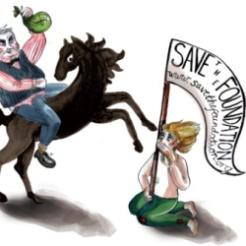Gareth Jones argues that the campaign on behalf of the Lloyds TSB Foundation for Scotland is focusing on the wrong issue, and that the Foundation must compromise if it is to prevent Scottish charities' funding shortfall.
This week, an alliance of grass-roots community groups, led by a black horse called Lloyd, will march down Dumbarton High Street in protest at the Lloyds Banking Group’s decision to cancel its covenant with the Lloyds TSB Foundation for Scotland.
However, while it’s easy to pour scorn on banks after events of the last few years, the situation is not quite as clear-cut as it might seem.
The Bank’s covenant with the Foundation contains a nine-year break clause in case circumstances change. If the Bank decides that 1 per cent is now too large a proportion of its profits to donate to charity, it is perfectly entitled to do so, and the Scottish charitable sector has no divine right to the money.
The cancellation of the covenant itself isn't even that much of a problem for the sector. Given the huge expansion of the Banking Group following the acquisition of HBOS last year, once the Group returns to full profitability (it has already announced that it made a profit in the first quarter of this year) Scottish charities stand to receive even more from the Foundation than they ever have done in the past.
And when the covenant ceases in nine years time, the Banking Group has promised to set up a new grantmaker, the Bank of Scotland Foundation, which will presumably fund Scottish charities on the same terms as were agreed with the other UK regional foundations, receiving a share of 0.5 per cent of bank's profits.
The real problem here is the shortfall in funding while the Banking Group returns to full profitability.
Many charities are reliant on this funding and its withdrawal is causing them to cut services and may even lead to closures, so campaigners need to be focusing their efforts on an advance of funding to cover this shortfall.
Apportioning blame
One aspect that seems to have been lost in the debate is that the Foundation’s chief executive Mary Craig and her trustees must ultimately take some responsibility for the situation.
Their strategy has been to preserve the full value of the covenant in perpetuity by gambling the wellbeing of Scottish charities in the shorter-term, in the hope that they could publicly pressure the Banking Group to back down. This strategy has not been successful.
On the flipside, it is true is that the Bank has been rather unfair in refusing to advance any future payments to cover the near-term shortfall unless the Foundation agrees to renegotiate the terms of the covenant.
It is seemingly using the financial threat to Scottish charities as a leverage tool in its (now dormant) negotiations with the Foundation.
The compromise
The solution is this. Having now decided to create its own foundation once the covenant expires, the Banking Group should agree to advance some of the money likely to be paid over the next nine years to help charities that are currently having difficulties.
This will be tricky however as negotiations have broken down. As such, the Foundation’s negotiators will have to accept that maintaining the covenant as its stands is no longer an option, and return to the table to agree an advance in funding.
If Scottish charities are to be saved, both sides need to be prepared to give a little in negotiations.









